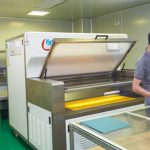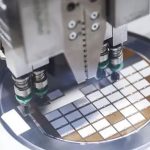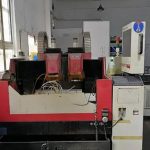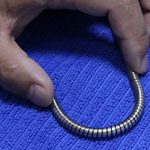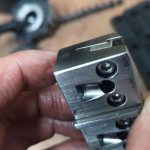Deprecated: get_settings is deprecated since version 2.1.0! Use get_option() instead. in /www/sites/alloy.wiki/index/wp-includes/functions.php on line 4862
The curvature of the combined curved surface, which is closely related to CNC machining, avoids the blindness of the transition fillet radius selection in the previous CAD modeling, so that in the processing process, it is not impossible to process due to the transition surface or replace the tool with a smaller radius, which reduces the processing efficiency . This method provides a new idea for the surface transition technology, and at the same time is conducive to the realization of CAD/CAM-integration. Phase 6 is often used in actual product design. The so-called composite surface is to combine different surface patches in a certain way. Although the combined surface composed of connected surfaces can express complex shapes conveniently, it brings another problem, which is the transition problem between the surfaces in the combined surface. It is extremely difficult, or even impossible, so people use transition surfaces between composite surfaces to deal with the transition problem between surfaces. Due to the important role of transition surfaces in product performance, appearance processing, etc., there are more studies in this area. Although there are many researches on curved surface transition problems and the algorithms are getting more and more perfect, they only study transition problems from a mathematical point of view, without considering the processing requirements, so the established transition surface may not be processed or must be processed. Increasing the number of tool changes will reduce the processing efficiency. For this reason, this article intends to study the surface transition technology from the perspective of CNC machining. 1 Free-form surface smooth transition theory When connecting and transitioning composite surfaces with curved surfaces, the transition surface and the composite surface must be connected. Satisfy certain smoothness (also called smoothness) requirements. Currently, there are two different measures of connection smoothness: one is traditional parameter continuity, and the other is geometric continuity. The definition of parameter continuity is : If and only if the two surfaces P(s, t) and Q(u, v) along their regular common connection line P (V=Q(V) everywhere there is a partial derivative up to the order, then they are said to be connected along the The line has n-th order parametric continuity or C1 continuity. The definition of geometric continuity is: two surfaces P(s, t) and Q(u, v) along their regular common connecting line P(V)=Q (V) It has n-order geometric continuity or continuity of G. If and only if one of them can be re-parameterized so that they have n-parameter continuity or C1 continuity along the common connection line. People It is gradually realized in practice that traditional parametric continuity is appropriate when measuring the smoothness of non-parametric curved surfaces, but it is an unnecessary excess of smoothness when used for the smoothness of parametric curved surfaces. Therefore, it cannot accurately measure the smoothness of the parametric surface. Geometric continuity is the necessary relaxation for parameter continuity and the necessary relaxation for parameterization, but it is by no means a relaxation of smoothness. In this way, it can be a shape Definition and shape control provide additional degrees of freedom. Therefore, geometric continuity is an ideal measure for the smoothness of parametric surfaces. Considering that parametric surfaces have become the standard expression of free-form surfaces, this article also uses geometric continuity to deal with transitional surfaces and The smoothness of the connection between the combined surfaces and the comprehensive consideration of the principles of accuracy and benefit, this paper only uses G1 and the first-order geometric continuity. The continuity can be expressed as: two surfaces P (s, t) and Q (u, v) along Their regular common connection line P(V=Q(V has first-order geometric continuity or G1 continuity, if and only if they have a common tangent plane or a common surface normal along the common connection line.
2 Surface transition technology for CNC machining As mentioned above, the transition of curved surfaces in the current geometric modeling system is only from a mathematical point of view and does not take into account the requirements of CNC machining. The smoothness requirements on the above, more importantly, it takes into account the characteristics of CNC machining. The curved surface transition technology mainly includes the following 2.1 Discretization of composite surfaces and finding the dispersion of the intersection of composite surfaces to free-form surfaces. There are many current researches, and the algorithm is relatively mature. I will not do in-depth analysis here. This article uses triangular discreteness. The method is to discretize the combined surface. For the specific implementation of this method, please refer to the relevant combined surface after being discretized. It is also very easy to solve their intersection line (approximately represented by micro-line segments), and I will not repeat it here. Combine curved surfaces and get the intersection line. Currently, the CNC machining of combined curved surfaces generally has three types: operator method, area processing method and section method. Among them, the section method is to plan the tool position trajectory on a set of parallel planes, and usually a set of planes perpendicular to the XY plane. This method is the most commonly used method in combined surface processing, which can treat the combined surface as a whole For processing, the tool path spans the entire combined surface, and the processing efficiency is high. Therefore, this article also proposes a transition method of combined curved surface for this processing method. When a plane perpendicular to the XY plane is used to section a discrete composite surface, the intersection line represented by the micro-line segment can also be easily obtained.
2.3 Find the curvature of the composite surface at the intersection line. After finding the intersection of the composite surface and the plane, you can find the curvature of the surface at the intersection of the cross-section plane and each side of the triangle (the end point of each micro-line segment). The process is h-surface ** invariant, E=Pu.Pu, the second invariant of the surface, L=n°Pm. After the normal curvature is obtained, the maximum curvature of the point can be obtained by solving for its extreme value. The extreme value formula is that when the curvature of the surface at the intersection of the combined surface and the section plane is calculated, the following formula can be used to calculate the next section plane and the current section plane d-the smallest radius of curvature along the section plane on the combined surface , H one by one allowable residual height, mm At the same time, note the maximum value of the curvature of the surface on the intersection of the current section plane and the combined surface. In this way, the maximum value of the curvature of the curved surface at the intersection of each section plane and the combined curved surface can be obtained.
4Analyze and determine the reasonable transition radius of the combined surface. After the maximum value of the curvature at each cross-section plane is calculated, the transition radius of the combined surface can be analyzed and judged in the CNC machining, and the generation of the interference-free tool position trajectory, especially the trajectory Interference inspection and processing is the most complicated link. The choice of tool radius (here refers to the ball-end tool) and the number of tool changes during processing are the two* main factors that affect processing efficiency. If considered separately, the larger the tool radius, the higher the processing efficiency; the fewer the number of tool changes, the higher the processing efficiency. However, for a given curved surface, the larger the selected tool radius, often means an increase in the number of tool changes. The goal of this paper is to make the combined surface not reduce the efficiency due to the increase of the transition surface. Based on this, we propose the transition radius of curvature criterion as follows: if the combined surface has a clear numerical requirement for the transition radius of curvature, the transition radius corresponding to each section plane Is the required value; otherwise, if the largest of the maximum curvatures corresponding to all section planes is less than the curvature of the ball head of the economical tool, the economical tool is the most economical tool, and the tool makes the machining efficiency the highest, then each section corresponds to The transition radius is the radius of the ball nose of the tool; otherwise, the transition radius corresponding to each cross-sectional plane of the combined surface is the reciprocal of the maximum curvature corresponding to the cross-sectional plane. 2.5 Use cubic B-spline surface for fitting to obtain the transition surface. After obtaining the transition radius corresponding to each section plane of the combined surface, we first use the arc with the radius of curvature to make G1 smooth fillet transition on the section line of the combined surface corresponding to the same section plane. In this way, we get a series of arcs , And write down the start point and end point of each transition arc segment, that is, the intersection point of the transition arc and the intersection line of the composite surface. The line connecting these start points and end points is the common connection line of the composite surface and the transition surface. Then we use surface fitting technology to fit this series of arcs to obtain the required transition surface. This paper uses cubic quasi-uniform B-spline surface as the form of the fitting surface. As mentioned earlier, this paper adopts G1 continuity as the smoothing criterion of the combined curved surface and the transition surface. The criterion is expressed as follows: two surfaces P(s, t) and Q(u, v) are along their regular common connecting line P(V)=Q(V has first-order geometric continuity or continuity, if and only When the four non-coincident tangent vectors Ps(V,Pt(V) along the common connecting line should be coplanar, the coplanar condition can be expressed mathematically as (PXP,<(Q)
Link to this article:Transition technology of combined free-form surface for NC machining
Reprint Statement: If there are no special instructions, all articles on this site are original. Please indicate the source for reprinting:Alloy Wiki,thanks!^^



